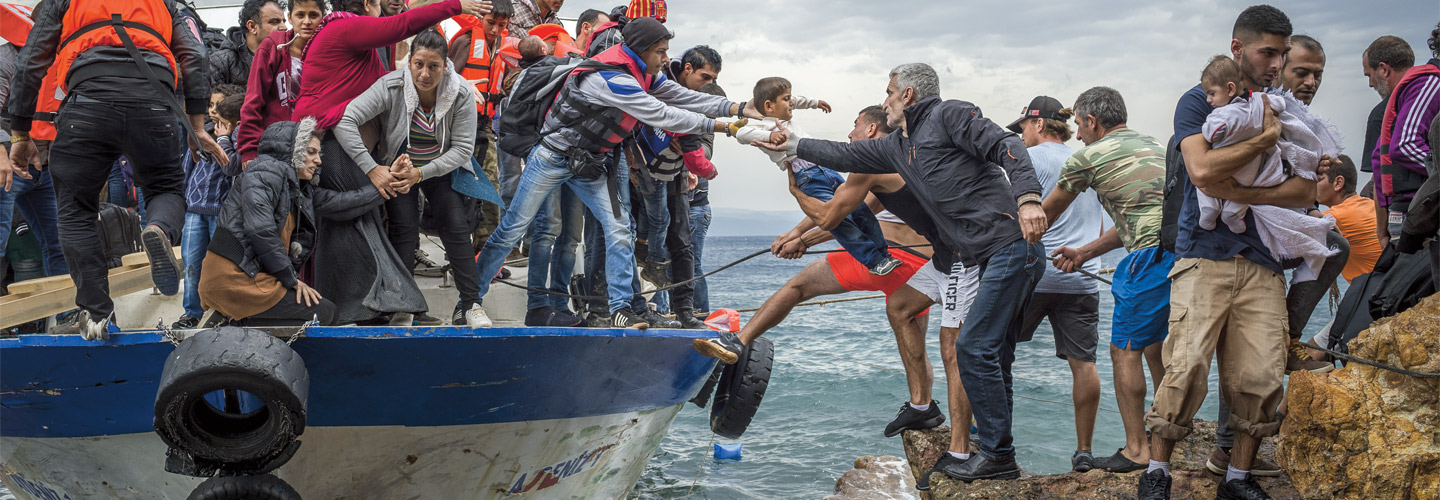Last year, Ahmad Dandoush, 22, along with two dozen others, crammed into a rubber boat designed for eight people. They set off from Turkey, heading across the dangerous waters of the Aegean Sea—an arm of the Mediterranean Sea—for Greece.
The Syrians, Afghans, and Iraqis who were packed into the boat were refugees fleeing violence in their homelands. Each had paid $1,000 to smugglers, hoping to reach Europe and its promise of a new life. Dandoush, who grew up in the Syrian city of Latakia, was escaping from that nation’s civil war, which has killed nearly 500,000 people since 2011 and caused millions to flee.
“We all knew what happened to other refugees, that some had died,” Dandoush recalls. “We just wanted to get to Greece alive.”
When they reached the shores of the Greek island of Lesbos, Dandoush was among the first to spring from the boat—his first step on what would become a three-month-long journey across Europe by train, by taxi, and on foot. By the time he arrived in Weimar, Germany, last October, the trip had taken him through five countries: Greece, Macedonia, Serbia, Hungary, and Austria. The journey cost him $3,000 and left him 20 pounds lighter.
Dandoush is one of more than 440,000 migrants who made their way to Germany last year and applied for asylum—protection given by a government to someone who has left his or her country to escape war or persecution. They’re part of the biggest refugee crisis Europe has experienced since the end of World War II (1939-1945). Germany, with its strong economy and generous social welfare benefits, has been a top destination for the mostly Middle Eastern migrants.
Last year, Ahmad Dandoush, 22, and two dozen other people crammed into a rubber boat designed for eight passengers. The migrants and refugees set off from Turkey, headed for Greece. They traveled across the dangerous waters of the Aegean Sea, which is an arm of the Mediterranean Sea.
The Syrians, Afghans, and Iraqis who were packed into the boat were fleeing violence in their homelands. Each had paid $1,000 to smugglers, hoping to reach Europe and its promise of a new life. Dandoush grew up in the Syrian city of Latakia. He was escaping from Syria’s civil war, which has killed nearly 500,000 people since 2011 and caused millions to flee.
“We all knew what happened to other refugees, that some had died,” Dandoush recalls. “We just wanted to get to Greece alive.”
When the boat reached the shores of the Greek island of Lesbos, Dandoush was among the first to spring from the boat. It was his first step on what would become a three-month-long journey across Europe by train, by taxi, and on foot. Last October, he arrived in Weimar, Germany. The trip had taken him through five countries: Greece, Macedonia, Serbia, Hungary, and Austria. It had cost him $3,000 and left him 20 pounds lighter.
Dandoush is one of more than 440,000 migrants who made their way to Germany last year and applied for asylum. (Asylum is protection given by a government to someone who has left his or her country to escape war or persecution.) These migrants are part of Europe's biggest refugee crisis since the end of World War II (1939-1945). Germany has a strong economy and generous social welfare benefits. That makes it a top destination for the mostly Middle Eastern migrants.

